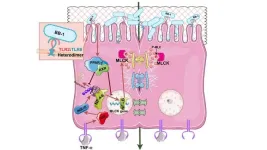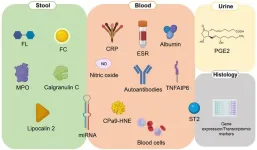(Press-News.org) GRAND RAPIDS, Mich. (Aug. 22, 2024) — Immune cells use two different routes to produce acetyl-CoA, an essential metabolite required to fight infection and cancer, reports a study led by Van Andel Institute scientists.
The findings, published in the Journal of Experimental Medicine, could help improve immunotherapies by revealing how diet can boost immune cell function.
“Like any good system, immune cells have a plan A and a plan B,” said Russell Jones, Ph.D., the study’s corresponding author and chair of VAI’s Department of Metabolism and Nutritional Programming. “We’ve pinpointed how these cells use a two-pronged approach to ensure they have enough acetyl-CoA to do their jobs and keep us healthy. Importantly, we gained new insights that may inform tailored dietary strategies for augmenting existing cancer treatments.”
Cells synthesize acetyl-CoA using nutrients, such as acetate, derived from food. When a threat is detected, cells add acetyl-CoA to certain proteins, which then unlock access to the genetic instructions required to fight disease and infection. Insufficient acetyl-CoA derails the immune system’s ability to protect the body.
Until now, however, it was unclear exactly how immune cells maintained their acetyl-CoA reserves. In their new study, Jones and his colleagues identified two routes for acetyl-CoA production — a main route called ACLY and a backup route called ACSS2. Cells prefer ACLY but, in the event of problems, ACSS2 picks up the slack to ensure a continual supply of acetyl-CoA.
Although this type of “metabolic flexibility” has been observed in cancer cells, this is the first time immune cells have been shown to have similar abilities.
The findings also underscore the close relationship between metabolism and epigenetics, which are processes that influence how the instructions in DNA are used without changing the DNA sequence itself. Epigenetic errors are well-known contributors to cancer and important targets for potential new treatments.
“We identified specific metabolic hubs, which include ACLY and ACSS2, that control cell function through epigenetics,” said McLane Watson, Ph.D., the study’s co-first author and a postdoctoral fellow in Jones’ lab. “This is exciting because these hubs could one day inform new ways to improve cancer immunotherapies by using metabolism to fine-tune epigenetics.”
Watson and Irem Kaymak, Ph.D., are co-first authors of the study. Other authors include Brandon M. Oswald, Benjamin Johnson, Ph.D., Lisa M. DeCamp, Batsirai M. Mabvakure, Ph.D., Katarzyna M. Luda, Ph.D., Eric H. Ma., Ph.D., Kin Lau, Ph.D., Zhen Fu, Ph.D., Brejnev Muhire, Ph.D., Susan M. Kitchen-Goosen, Alexandra Vander Ark, M.S., Michael S. Dahabieh, Ph.D., Matthew Vos, Hui Shen, Ph.D., Connie M. Krawczyk, Ph.D., Kelsey S. Williams, Ph.D., and Ryan D. Sheldon, Ph.D., of VAI; Shixin Ma, Ph.D., and Susan M. Kaech, Ph.D., of Salk Institute for Biological Sciences; Bozena Samborska, M.Sc., of McGill University; Zi Peng Fan, Ph.D., Thomas P. Roddy, Ph.D., Gillian A. Kingsbury, Ph.D., and Cristovão M. Sousa, Ph.D., of Agios Pharmaceuticals; and Dominic G. Roy, Ph.D., of University of Montreal.
Research reported in this publication was supported by Van Andel Institute; the National Cancer Institute of the National Institutes of Health under award no. T32CA251066 (Watson; PI: P. Jones); the Damon Runyon Cancer Research Foundation under award no. DRG-#2495-23 (Watson); and the National Institute of Allergy and Infectious Diseases of the National Institutes of Health under award no. R01AI165722 (R. Jones).
Roy is supported by the Fonds de Recherche due Québec – Santé (FRQS) and the Cancer Research Society under award no. 192049. Krawczyk is supported by the National Institute of Allergy and Infectious Diseases under award no. R21AI153997. Ma is supported by a Cancer Research Institute Fellowship and a Salk Pioneer Fund Postdoctoral Scholar Award. Kaech is supported by the National Institute of Allergy and Infectious Disease of the National Institutes of Health under award nos. R01AI066232 and R21AI151986. Jones also is supported by the Paul G. Allen Frontiers Group Distinguished Investigator Program and the Chan Zuckerberg Initiative DAF, an advised fund of the Silicon Valley Community Foundation.
The content is solely the responsibility of the authors and does not necessarily represent the official views of the National Institutes of Health or other funders.
###
ABOUT VAN ANDEL INSTITUTE
Van Andel Institute (VAI) is committed to improving the health and enhancing the lives of current and future generations through cutting edge biomedical research and innovative educational offerings. Established in Grand Rapids, Michigan, in 1996 by the Van Andel family, VAI is now home to more than 500 scientists, educators and support staff, who work with a growing number of national and international collaborators to foster discovery. The Institute’s scientists study the origins of cancer, Parkinson’s and other diseases and translate their findings into breakthrough prevention and treatment strategies. Our educators develop inquiry-based approaches for K–12 education to help students and teachers prepare the next generation of problem-solvers, while our Graduate School offers a rigorous, research-intensive Ph.D. program in molecular and cellular biology. Learn more at vai.org.
END
Many quantum devices, from quantum sensors to quantum computers, use ions or charged atoms trapped with electric and magnetic fields as a hardware platform to process information.
However, current trapped-ion systems face important challenges. Most experiments are limited to one-dimensional chains or two-dimensional planes of ions, which constrain the scalability and functionality of quantum devices. Scientists have long dreamed of stacking these ions into three-dimensional structures, but this has been very difficult ...
Philadelphia, August 22, 2024 – There is a critical unmet need to help tighten and maintain a healthy intestinal barrier and treat a leaky gut. Researchers have now found that a unique strain of probiotic bacteria, Bifidobacterium bifidum BB1, enhances intestinal barrier function and protects against penetration of bacteria and various harmful agents in the intestine. The findings, detailed in an article in The American Journal of Pathology, published by Elsevier, can help advance the development of novel, targeted, naturally occurring probiotic therapy for patients with inflammatory bowel disease (IBD) and other inflammatory diseases, such as fatty liver disease or alcoholic liver ...
Researchers from the University of Colorado College of Nursing and CU School of Medicine on the Anschutz Medical Campus were awarded a $1.35 million grant from the Agency for Healthcare Research and Quality (AHRQ) to design and implement technologies that improve resident safety and employee wellbeing at long-term care facilities.
“Long-term care facilities in the United States are in crisis, they’re facing low resources and high staff turnover,” CU Nursing Associate Professor and ...
Researchers at the Wyss Institute for Biologically Inspired Engineering at Harvard University report that they were able to successfully put tadpoles of Xenopus laevis frogs into a hibernation-like torpor state using donepezil (DNP), a drug approved by the FDA to treat Alzheimer’s. The team had previously used another drug, SNC80, to achieve similar results in tadpoles and enhance the survival of whole mammalian hearts for transplants, but SNC80 is not approved for clinical use in humans because it can cause seizures. By contrast, DNP is already being used in the clinic, meaning it potentially could be rapidly repurposed ...
Preventing the next pandemic begins before diseases emerge. This “pre-emergence” phase is the focus of a new center funded by the U.S. National Science Foundation and led by the University of California, Davis.
Supported with $18 million over seven years, the U.S. National Science Foundation Center for Pandemic Insights (NSF CPI) includes partnering institutions from across the United States. It aims to harness new technologies and develop sensing to detect, investigate, and ultimately prevent ...
An estimated 462 million people around the world suffer from Type 2 diabetes, a chronic disease in which the body has problems using sugar as a fuel, leading to a buildup of sugar in the blood and chronic health issues.
New research led by Ayyalusamy Ramamoorthy, a professor at the FAMU-FSU College of Engineering and the Florida State University-headquartered National High Magnetic Field Laboratory, shows how zinc, pH levels and insulin work together to inhibit the buildup of protein clumps that contribute to this disease. The work, which points toward promising avenues for innovative treatments, ...
The global burden of inflammatory bowel diseases (IBD), primarily Crohn's disease (CD) and ulcerative colitis (UC), continues to rise. Recent data show incidence rates of up to 17.8 cases per 100,000 person-years for CD and even higher for UC, reaching 28.4 per 100,000 person-years. These diseases primarily affect older populations and vary geographically, with higher prevalence rates in highly developed countries. Currently, endoscopic assessment through ileo-colonoscopy is the gold standard for diagnosing and monitoring IBD. However, this approach is invasive and often has limited availability, leading to long ...
When exactly does the aging process start? With the aging mechanisms unclear, no consensus has been reached about aging “cliffs”, where our body functions and biological processes just change dramatically, as if overnight.
In 2019, a study published in the authoritative peer-reviewed journal Nature Medicine, based on plasma proteomics data, identified 34, 60, and 78 years old as key time points of aging. In August 2024, Nature Aging, a Nature portfolio journal focusing on aging mechanisms, published the latest findings incorporating comprehensive data including transcriptomics and metabolomics, pinpointing the aging cliffs to the 40s and 60s.
In the biomedical field, multi-omics ...
Non-living hydrogels can play the video game Pong and improve their gameplay with more experience, researchers report August 23 in the Cell Press journal Cell Reports Physical Science. The researchers hooked hydrogels up to a virtual game environment and then applied a feedback loop between the hydrogel’s paddle—encoded by the distribution of charged particles within the hydrogel—and the ball’s position—encoded by electrical stimulation. With practice, the hydrogel’s accuracy improved by up to 10%, resulting in longer rallies. The researchers say that this demonstrates ...
The anti-cancer drug olaparib may be effective in treating biochemically recurrent prostate cancer without accompanying hormone therapy for men who have mutations in genes such as BRCA2, according to results of a phase II clinical trial of 51 patients conducted at the Johns Hopkins Kimmel Cancer Center and three other sites.
The study was done of men experiencing signs of cancer recurrence after surgical removal of the prostate, as measured by a high level of the protein prostate-specific antigen (PSA). Following treatment with olaparib, 13 participants, including all 11 who had BRCA2 mutations, had a decrease in PSA of at least 50% ...






